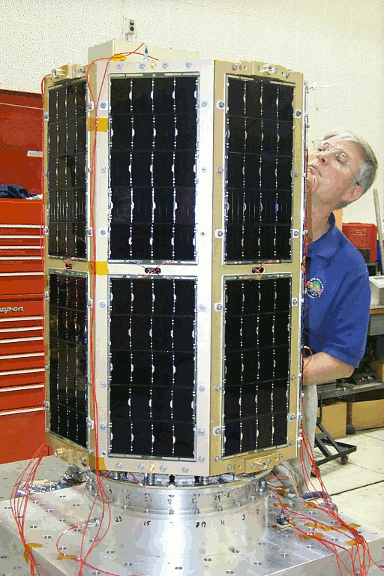Future of Solar Power and New Photovoltaic Materials

The MidSTAR-1 space satellite with its high efficiency gallium arsenide solar cells. Picture by USNA
Solar cells are becomng increasingly commonplace and research is constantly being done into new materials which may be introduced in the future to improve efficiency and cost-effectiveness. We have learned over the years that it's never a good idea to bet against silicon completely being replaced, but there are some very interesting thin film materials which are coming into play. Copper indium selenide is a an example of such a material with the added advantage of having a beautiful appearance which can be formed around curves and in shapes. It is likely that this will become more popular in the future, as well as cadmium telluride, as efficiencies for devices using these materials increase and new companies using them start up.
Organic photovoltaics still have a long way to go before they become commercial products, but the efficiencies are moving in the right direction and there will probably be some good applications using this technology eventually. There will probably be a multiplicity of technologies but in the next 25 years it is unlikely that silicon will be dispensed of. Fortunately it is one of the most abundant elements on Earth, and humanity has learned very well how to make relatively high efficiency devices from it. There will probably be more usage here on Earth of gallium arsenide and its alloys which currently make very high efficiency outer space devices. This could become used in large scale utilities and similar applications.
Thus, a mixture of technologies in the correct combinations will enable people to use the appropriate photovoltaic product for the right application. For example a calculator will use one type whereas a utilities plant in the middle of a desert will use another. There will simply be more usage of solar technology of it as time progresses. One of the big question marks for research and development is that once there are a lot of photovoltaic devices being used in the world as a significant percentage of power generation by utilities, how will the times when storage is required be handled when the sun is not shining? This is an interesting challenge, and is one of those which America's National Renewable Energy Laboratory are working on, with some very innovative ways to store energy in carbon nanotubes for example. There will probably also be an increase in companion research and development which goes with the energy generating work that solar cells provide.
The solar industry will need to continue to involve young students at college level and to engage them in these technologies earlier in their careers, in order to get the answers to how future solar energy will change the design and the experience of our cities and our individual homes. Part of what is exciting about America's solar decathlon contest for students is that it involves a collaboration between building designers and energy experts. This may be an unhappy union sometimes, but eventually things get sorted out. Engineers and architects work together, because they must, to make buildings both efficient and energy producing, as well as being aethetically pleasing to the eye. Looking to the future it will be today's young people who will decide how cities may morph. The idea of getting them interested in the problem early in ther careers is the secret to the transformation that must occur in the world's cities.
As an example of a look into the future, Project Manager at The National Renewable Energy Laboratory, Cecile Warner, pictures a day in her future live where she wakes up in her solar powered house and she has solar powered electricity to operate the stove to make her breakfast, then she hops into her plug-in hybrid car which as also charged up overnight by the house's solar system. If she has to drive somewhere she'll do it on a road that doesn't have too many fossil fuel emmissions. She'll work in a space that has a clever and smart design, although she already has that now in a laboratory building that is also designed for solar power. She imagines that the solar component of our lives becomes a completely natural and everyday thing, and doesn't think that the future, where we can all enjoy this, is very far away.

Credits: Cecile Warner, US National Renewable Energy Laboratory, World House Radio.
- Renewable Energy:
- Login to post comments
